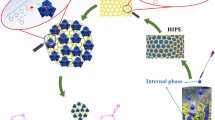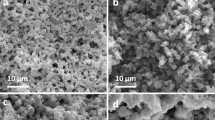Abstract
We report an efficient, highly selective and low-temperature three-dimensional hierarchically macro/mesostructured porous gold monoliths catalyzed reaction process for one-step oxidation of benzene to phenol with hydrogen peroxide as the green oxidant. The porous catalysts were characterized before calcination by FTIR and TGA and after calcination by XRD, FESEM-EDX and BET techniques. The selectivity of phenol production from the one-step oxidation of benzene over porous gold catalysts can be enhanced by concise tuning of pore diameter and pore surface morphology. From the results obtained, it was concluded that the balance between the decomposition rate of H2O2 and benzene adsorption over the catalyst surface is responsible for the outstanding catalytic performance of the three-dimensional macro/mesoporous gold monoliths.
Graphical Abstract
The as-synthesized series of nanoporous gold monoliths were evaluated for the first time as alternative heterogeneous catalysts for the direct catalytic oxidation of benzene to phenol at low temperature. Therefore, it is of great interest to “switch-off” other time- and energy-consuming reactions and promote the hydroxylation of benzene with porous Au catalysts.










Similar content being viewed by others
References
Xia BY, Ng WT, Wu HB, Wang X, Lou XW (2012) Self-supported interconnected Pt nanoassemblies as highly stable electrocatalysts for low-temperature fuel cells. Angew Chem Int Ed 51:7213–7216
Wang ZY, Luan DC, Li M, Su FB, Madhavi S, Boey F, Lou XW (2010) Engineering nonspherical hollow structures with complex interiors by template-engaged redox etching. J Am Chem Soc 132:16271–16277
Naikoo GA, Dar RA, Khan F (2014) Hierarchically macro/mesostructured porous copper oxide: facile synthesis, characterization, catalytic performance and electrochemical study of mesoporous copper oxide monoliths. J Mater Chem A 2:11792–11798
Sun FQ, Cai WP, Li Y, Jia LC, Lu F (2005) Direct growth of mono- and multilayer nanostructured porous films on curved surfaces and their application as gas sensors. Adv Mater 17:2872–2877
Zhou L, Zhao DY, Lou XW (2012) LiNi0.5Mn1.5O4 hollow structures as high-performance cathodes for lithium-ion batteries. Angew Chem Int Ed 51:239–241
Kresge CT, Leonowicz ME, Roth WJ, Vartuli JC, Beck JS (1992) Ordered mesoporous molecular sieves synthesized by a liquid-crystal template mechanism. Nature 359:710–712
Naikoo GA, Dar RA, Thomas M, Sheikh MUD, Khan F (2015) Hierarchically porous metallic silver monoliths: facile synthesis, characterization and its evaluation as an electrode material for supercapacitors. J Mater Sci Mater Electron 26:2403–2410
Dar RA, Naikoo GA, Kalambate PK, Giri L, Khan F, Karna SP, Srivastava AK (2015) Enhancement of the energy storage properties of supercapacitors using graphene nanosheets dispersed with macro-structured porous copper oxide. Electrochim Acta 163:196–203
Sirotin SV, Moskovskaya IF (2009) Liquid-phase oxidation of benzene and phenol on MCM-41 mesoporous molecular sieves modified with iron and cobalt compounds. Pet Chem 49:99–105
Zhu YJ, Dong YL, Zhao L, Yuan FL (2010) Preparation and characterization of mesopoous VOx/SBA-16 and their application for the direct catalytic hydroxylation of benzene to phenol. J Mol Catal A Chem 315:205–212
Qi XY, Li JY, Ji TH, Wang YJ, Feng LL, Zhu YL, Fan XT, Zhang C (2009) Catalytic benzene hydroxylation over copper-substituted aluminophosphate molecular sieves (CuAPO-11). Microporous Mesoporous Mater 122:36–41
Dimitrova R, Spassova M (2007) Hydroxylation of benzene and phenol in presence of vanadium grafted beta and ZSM-5 zeolites. Catal Commun 8:693–696
Groves JK (1972) The Friedel–Crafts acylation of alkenes. Chem Soc Rev 1:73–97
Yang JH, Sun G, Gao Y, Zhao H, Tang P, Tan J, Lu AH, Ma D (2013) Direct catalytic oxidation of benzene to phenol over metal-free graphene-based catalyst. Energy Environ Sci 6:793–798
Lou XW, Archer LA, Yang Z (2008) Hollow micro-/nanostructures: synthesis and applications. Adv Mater 20:3987–4019
Mehta SK, Kumar S, Chaudhary S, Bhasin KK (2009) Effect of cationic surfactant head groups on synthesis, growth and agglomeration behavior of ZnS nanoparticles. Nanoscale Res Lett 4:1197–1208
Xiao J, Yang S (2010) Hollow calcite crystals with complex morphologies formed from amorphous precursors and regulated by surfactant micellar structures. CrystEngComm 12:3296–3304
Zhang H, Tang C, Lv Y, Sun C, Gao F, DongChen Y. L, Chen Y (2012) Synthesis, characterization, and catalytic performance of copper-containing SBA-15 in the phenol hydroxylation. J Colloid Interface Sci 380:16–24
Venkatathri N (2008) Influence of template on synthesis and characterization of novel mesoporous silica nanosphere. Indian J Chem 47:1823–1825
Chaudhary S, Rohilla D, Mehta SK (2014) Surfactant adsorption and aggregate structure of silica nanoparticles: a versatile stratagem for the regulation of particle size and surface modification. Mater Res Express 1:015011
Khan F, Eswaramoorthy M, Rao CNR (2007) Macroporous silver monoliths using a simple surfactant. Solid State Sci 9:27–31
Khan F, Mann S (2009) Fabrication of metal and metal oxide sponges by self-bubbled triton X-45 hydrogel templates. J Phys Chem C 113:19871–19874
Walsh D, Arceli I, Ikoma T, Tanaka S, Mann S (2003) Dextran templating for the synthesis of metallic and metal oxide sponges. Nat Mater 2:386–390
Su R, Kesavan L, Jensen MM, Tiruvalam R, He Q, Dimitratos N, Wendt S, Glasius M, Kiely CJ, Hutchings GJ, Besenbacher F (2014) Selective photocatalytic oxidation of benzene for the synthesis of phenol using engineered Au–Pd alloy nanoparticles supported on titanium dioxide. Chem Commun 50:12612–12614
Tanev PT, Chibwe M, Pinnavaia TJ (1994) Titanium-containing mesoporous molecular sieves for catalytic oxidation of aromatic compounds. Nature 368:321–323
Balducci L, Bianchi D, Bortolo R, D’Aloisio R, Ricci M, Tassinari R, Ungarelli R (2003) Direct oxidation of benzene to phenol with hydrogen peroxide over a modified titanium silicalite. Angew Chem Int Ed 42:4937–4940
Thetford A, Hutchings GJ, Taylor SH, Willock DJ (2011) The decomposition of H2O2 over the components of Au/TiO2 catalysts. Proc R Soc A. doi:10.1098/rspa.2010.0561
Wang X, So L, Su R, Wendt S, Hald P, Mamakhel A, Yang C, Huang Y, Iversen BB, Besenbacher F (2014) The influence of crystallite size and crystallinity of anatase nanoparticles on the photo-degradation of phenol. J Catal 310:100–108
Chen X, Zhang J, Fu X, Antonietti M, Wang X (2009) Fe–g–C3N4-catalyzed oxidation of benzene to phenol using hydrogen peroxide and visible light. J Am Chem Soc 131:11658–11659
Gao S, Jai X, Yang J, Wei X (2012) Hierarchically micro/nanostructured porous metallic copper: convenient growth and super hydrophilic and catalytic performance. J Mater Chem 22:21733–21739
Acknowledgments
The authors acknowledge the UGC New Delhi for financial support through the Central University Fellowship (CUF) and Rajiv Gandhi National Fellowship (RGNF). The authors are thankful to Head, Department of Chemistry, Dr. Hari Singh Gour Central University Sagar (MP), India, for providing the necessary facilities. Our acknowledgment is incomplete without thanking our two faculty members Prof. T. S. S. Rao (D.Sc. Germany) and Dr. K. B. Joshi (Humboldt Fellow) for their valuable suggestions to carry out the work successfully.
Author information
Authors and Affiliations
Corresponding author
Ethics declarations
Conflict of interest
All authors have approved the manuscript and agreed for submitting this original research in this esteemed journal. So, there is no conflict of interest.
Rights and permissions
About this article
Cite this article
Naikoo, G.A., Thomas, M., Sheikh, M.U.D. et al. Hierarchically macro/mesostructured porous Au monoliths: simple synthesis, characterization and catalytic performance. J Sol-Gel Sci Technol 76, 599–607 (2015). https://doi.org/10.1007/s10971-015-3810-5
Received:
Accepted:
Published:
Issue Date:
DOI: https://doi.org/10.1007/s10971-015-3810-5




